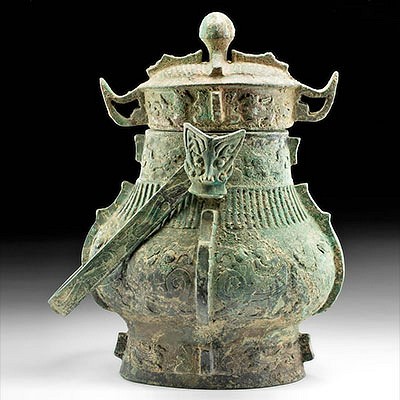Impressive Egyptian Cartonnage Sarcophagus Lid Panel
Lot 3b
About Seller
Artemis Fine Arts
686 S Taylor Ave, Ste 106
Louisville, CO 80027
United States
Selling antiquities, ancient and ethnographic art online since 1993, Artemis Gallery specializes in Classical Antiquities (Egyptian, Greek, Roman, Near Eastern), Asian, Pre-Columbian, African / Tribal / Oceanographic art. Our extensive inventory includes pottery, stone, metal, wood, glass and textil...Read more
Estimate:
$2,000 - $3,000
Absentee vs Live bid
Two ways to bid:
- Leave a max absentee bid and the platform will bid on your behalf up to your maximum bid during the live auction.
- Bid live during the auction and your bids will be submitted real-time to the auctioneer.
Bid Increments
| Price | Bid Increment |
|---|---|
| $0 | $25 |
| $300 | $50 |
| $1,000 | $100 |
| $2,000 | $250 |
| $5,000 | $500 |
| $10,000 | $1,000 |
| $20,000 | $2,500 |
| $50,000 | $5,000 |
| $100,000 | $10,000 |
| $200,000 | $20,000 |
About Auction
By Artemis Fine Arts
Jul 1, 2020
Set Reminder
2020-07-01 10:00:00
2020-07-01 10:00:00
America/New_York
Bidsquare
Bidsquare : Ancient | Near-Eastern | Asian Art
https://www.bidsquare.com/auctions/artemis-gallery/ancient-near-eastern-asian-art-5276
Ancient art from Egypt, Greece, Italy and the Near East, as well as Asian, Fossils, Pre-Columbian, Native American, African / Tribal / Oceanic, Spanish Colonial, Russian Icons, Fine art, much more! Artemis Fine Arts info@artemisgallery.com
Ancient art from Egypt, Greece, Italy and the Near East, as well as Asian, Fossils, Pre-Columbian, Native American, African / Tribal / Oceanic, Spanish Colonial, Russian Icons, Fine art, much more! Artemis Fine Arts info@artemisgallery.com
- Lot Description
Egypt, Late Dynastic Period, 26th to 31st Dynasty, ca. 664 to 332 BCE. A sizable sarcophagus lid fragment that is carved from cedar and layered with gesso-topped linen. The serene likeness of the deceased protrudes outward with flesh-toned pigments, white eyes bearing elongated outer canthi, and finely sculpted facial features like the full lips and prominent nose. Lining the jaw is a chinstrap which holds a black false beard accentuated with white chevrons indicative of pleating. Vertical blue and white stripes race down the lappets of the tripartite wig, and a meticulously decorated wesekh pectoral collar is painted across the upper chest. A colorful and intricately adorned example of ancient Egyptian funerary tradition. Mounted on modern wood display plaque. Size: 15.75" W x 20.8" H (40 cm x 52.8 cm); 21.625" H (54.9 cm) on included custom display plaque.
Ancient Egyptians believed it was of the utmost importance to preserve a body of the deceased, because the soul needed a place to reside after the death. Preservation of the body was done via mummification - a process involving the removal of internal organs that were placed in canopic jars, wrapping body in linen, and then embalming. Death masks and sarcophagus panels like this example were created so that the "ba" - the part of the soul that left the body each day - could recognize their old form body and become rejoined each evening with the "ka" - the part of the soul that permanently stayed with the body.
Provenance: private J.H. collection, Beaverton, Oregon, USA, acquired around 2013; ex-Relics of the Nile, Lexington, Kentucky, USA
All items legal to buy/sell under U.S. Statute covering cultural patrimony Code 2600, CHAPTER 14, and are guaranteed to be as described or your money back.
A Certificate of Authenticity will accompany all winning bids.
We ship worldwide and handle all shipping in-house for your convenience.
#154740This is a fragment from a larger sarcophagus lid. Repaired from multiple large pieces, with chips and adhesive residue along break lines. Restoration to areas including corners of wig, side areas of false beard, and several areas of peripheries and wig lappets, with some fragmentary pieces adhered to new material. Nicks and abrasions to face, beard, wig, lappets, and peripheries, with several stable fissures, fading to original pigmentation, and minor splintering to some exposed wooden areas. Light earthen deposits and great remains of original pigment throughout.Condition
- Shipping Info
-
All shipping is handled in-house for your convenience. Your invoice from Artemis Gallery will include shipping calculation instructions. If in doubt, please inquire BEFORE bidding for estimated shipping costs for individual items.
-
- Buyer's Premium



 EUR
EUR CAD
CAD AUD
AUD GBP
GBP MXN
MXN HKD
HKD CNY
CNY MYR
MYR SEK
SEK SGD
SGD CHF
CHF THB
THB

















